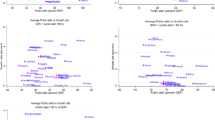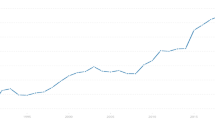Abstract
In this paper, we (1) examine the interactions of financial variables and the macroeconomy within the block-restriction vector autoregression model and (2) evaluate to what extent the financial variables improve the forecasts of GDP growth and inflation. For this reason, various financial variables are examined, including those unexplored in previous literature, such as the share of liquid assets in the banking industry and the loan loss provision rate. Our results suggest that financial variables have a systematic and statistically significant effect on macroeconomic fluctuations. In terms of forecast evaluation, financial variables in general seem to improve the forecast of macroeconomic variables, but the predictive performance of individual financial variables varies over time, even though it strengthens during the 2008–2009 crisis. The results give some support for the risk-taking channel of monetary policy, as the level of the monetary policy rate is positively associated with the loan loss provision rate of commercial banks. Finally, a more stable financial system is found to contribute to faster economic growth.









Similar content being viewed by others
Notes
For this purpose, the variables were standardized and the loan loss provisions and non-performing loans series were multiplied by −1.
This means that non-performing loans and loan loss provisions are multiplied by −1.
References
Assenmacher K, Gerlach S (2008a) Monetary policy, asset prices and macroeconomic conditions: a panel-var study, research series 200810-24, National Bank of Belgium
Assenmacher K, Gerlach S (2008b) Financial structure and the impact of monetary policy on asset prices, working papers 2008-16, Swiss National Bank
Babecka-Kucharcukova O (2009) Transmission of exchange rate shocks into domestic inflation: the case of the Czech Republic. Czech J Econ Finan 59(2):137–152
Baboucek I, Jancar M (2005) Effects of macroeconomic shocks to the quality of the aggregate loan portfolio, Czech National Bank working paper no. 2/2005
Bárta V, Singer M (2006) The Banking sector after 15 years of restructuring: Czech experience and lessons, BIS papers No. 28
Borys Morgese M, Franta M, Horváth R (2009) The effects of monetary policy in the Czech Republic: an empirical study. Empirica 36(4):419–443
Čihák M, Heřmánek J, Hlaváček M (2007) New approaches to stress testing the Czech banking sector. Czech J Econ Finan 57(1–2):41–59
Clark TE, West KD (2007) Approximately normal tests for equal predictive accuracy in nested models. J Econ 138:291–311
CNB (2009) Financial stability report, Czech National Bank
Cushman DO, Zha T (1997) Identifying monetary policy in a small open economy under flexible exchange rates. J Monet Econ 39:433–448
Elbourne A, de Haan J (2006) Financial structure and monetary policy transmission in transition countries. J Comp Econ 34(1):1–23
Estrella A, Rodrigues AP, Schich S (2003) How stable is the predictive power of the yield curve? Evidence from Germany and the United States. Rev Econ Stat 85(3):629–644
Forni M, Hallin M, Lippi M, Reichlin L (2003) Do financial variables help forecasting inflation and real activity in the euro area? J Monet Econ 50(6):1243–1255
Goodhart C, Hofmann B (2000) Do asset prices help to predict consumer price inflation? Manch Sch 68:122–140
Goodhart C, Hofmann B (2008) House prices, money, credit, and the macroeconomy. Oxf Rev Econ Policy 24(1):180–205
Goodhart C, Osorio C, Tsomocos D (2009) An analysis of monetary policy and financial stability: a new paradigm, CESifo working paper no. 2885
Hall P (1988) On symmetric bootstrap confidence intervals. J R Stat Soc B50:35–45
Holub T (2008) Causes of deviations from the CNB’s inflation targets: an empirical analysis. Czech J Econ Finan 58(9–10):425–433
Horváth R, Rusnák M (2009) How important are foreign shocks in a small open economy? The case of Slovakia. Global Econ J 9(1), Article 5
Jacobson T, Linde J, Roszbach K (2005) Exploring interactions between real activity and the financial stance. J Finan Stab 1:308–341
Jiménez G, Ongena S, Peydró JL, Saurina J (2009) Hazardous times for monetary policy: what do twenty-three million bank loans say about the effects of monetary policy on credit risk? Banco de Espana working papers 0833, Banco de España
Lucchetta M (2007) What do data say about monetary policy, bank liquidity and bank risk taking? Econ Notes 36(2):189–203
Lütkepohl H (2006) New introduction to multiple time series analysis, 1st edn. Springer-Verlag, Berlin
Maćkowiak B (2006) How much of the macroeconomic variation in Eastern Europe is attributable to external shocks? Comp Econ Stud 48(3):523–544
Mojon B, Peersman G (2001) A VAR description of the effects of monetary policy in individual countries of the euro area, ECB working paper no. 92
Parrado E (2001) The effects of foreign and domestic monetary policy in a small open economy: the case of Chile, central bank of Chile working paper no. 108
Stock JH, Watson MW (1998) Variable trends in economic time series. J Econ Perspect 2(3):147–174
Stock JH, Watson MW (2003) Forecasting output and inflation: the role of asset prices. J Econ Lit 41(3):788–829
Stock JH, Watson MW (2008) Phillips curve inflation forecasts, NBER working papers 14322, National Bureau of Economic Research, Inc.
Zha T (1999) Block recursion and structural vector autoregressions. J Econ 90:291–316
Acknowledgments
We thank two anonymous referees, Jan Brůha, Zuzana Fungáčová, Jan Hanousek, and seminar participants at the Czech National Bank and the 11th International Conference “Financial and Monetary Stability in Emerging Countries” (Bucharest, Romania). This research was supported by Czech National Bank Research Project B3/10. The financial support from the Czech Science Foundation research grant no. P402/11/1487 is gratefully acknowledged.
Author information
Authors and Affiliations
Corresponding author
Additional information
The views expressed in this paper are not necessarily those of the Czech National Bank.
Rights and permissions
About this article
Cite this article
Havránek, T., Horváth, R. & Matějů, J. Monetary transmission and the financial sector in the Czech Republic. Econ Change Restruct 45, 135–155 (2012). https://doi.org/10.1007/s10644-011-9106-z
Received:
Accepted:
Published:
Issue Date:
DOI: https://doi.org/10.1007/s10644-011-9106-z




